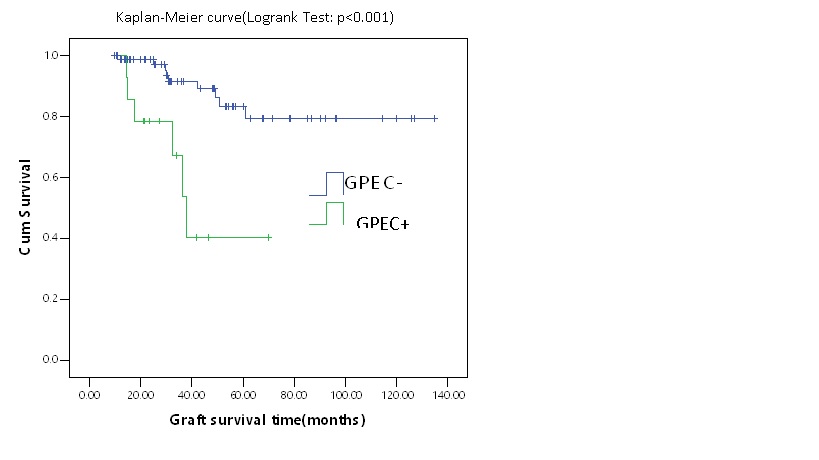Poor Outcome of Polyomavirus -Associated Nephropathy with Glomerular Parietal Epithelial Cells Infected by Polyomavirus.
1Department of Organ Transplantation, The First Affiliated Hospital, Sun Yat-sen University, Guangzhou, China
2Department of Pathology, The First Affiliated Hospital, Sun Yat-sen University, Guangzhou, China
Meeting: 2017 American Transplant Congress
Abstract number: A221
Keywords: Epithelial cells, Graft survival, Kidney transplantation, Polyma virus
Session Information
Session Name: Poster Session A: Kidney: Polyoma
Session Type: Poster Session
Date: Saturday, April 29, 2017
Session Time: 5:30pm-7:30pm
 Presentation Time: 5:30pm-7:30pm
Presentation Time: 5:30pm-7:30pm
Location: Hall D1
Background: Bowman's capsular epithelium infected by polyomavirus(Py) in polyomavirus -associated nephropathy (PyVAN) is infrequent and considered as the advanced stage of the disease. The aim of this study is to identify its characteristics and outcomes.
Methods: Between 2007 and 2016, we diagnosed PyVAN in 103 patients. Immunohistochemistry ever showed infection of Bowman's capsular epithelium in 15 (14.6%) patients. Clinical parameters at diagnosis, and long-term graft survival rates were compared between glomerular parietal epithelial cells infected by Py (GPEC+) and GPEC- groups.
Results: There were no difference between the two groups in gender, donor source, immunosuppressive regimen, the mean level of serum creatinine at diagnosis and the rate of acute rejection and delayed graft function, etc. The median viral load in urine and plasma at diagnosis were higher in GPEC+ group than those in GPEC- group but without statistical significance. Patients in GPEC+ group were characterized by the higher mean scores of viral cytopathic changes (cy) and interstitial inflammation (i). After 28.6±30.2 months follow-up, frequencies of graft loss was higher in GPEC+ group, which showed worse graft survival rates (p<0.05).
| GPEC+ (n=15 ) | GPEC- (n=88 ) | P | |
| Scr at diagnosis (umol/L) | 217.4 | 189.1 | 0.184 |
| BK viruria | 1.94 [times]109 | 9.72[times]108 | 0.361 |
| BK viremia | 6.04 [times]104 | 2.07 [times]104 | 0.080 |
| Graft loss at the latest follow-up[n(%)] | 46.2(0) | 9(11.0) | 0.002 |
| Scr at the latest follow-up(umol/L) | 187.5 | 185.1 | 0.933 |
The 1, 3, 5 year graft survival rates in GPEC+ group were only 92.9%, 53.9% and 40.4%, respectively.  Conclusions: PyVAN with GPEC infected by Py is characterized by extensive viral cytopathic effect and interstitial inflammation in graft biopsy. Although this subset of PyVAN is uncommon, it means the advanced stage of the disease with poor outcome.
Conclusions: PyVAN with GPEC infected by Py is characterized by extensive viral cytopathic effect and interstitial inflammation in graft biopsy. Although this subset of PyVAN is uncommon, it means the advanced stage of the disease with poor outcome.
CITATION INFORMATION: Huang G, Chen W, Qiu J, Chen X, Chen L, Wang C. Poor Outcome of Polyomavirus -Associated Nephropathy with Glomerular Parietal Epithelial Cells Infected by Polyomavirus. Am J Transplant. 2017;17 (suppl 3).
To cite this abstract in AMA style:
Huang G, Chen W, Qiu J, Chen X, Chen L, Wang C. Poor Outcome of Polyomavirus -Associated Nephropathy with Glomerular Parietal Epithelial Cells Infected by Polyomavirus. [abstract]. Am J Transplant. 2017; 17 (suppl 3). https://atcmeetingabstracts.com/abstract/poor-outcome-of-polyomavirus-associated-nephropathy-with-glomerular-parietal-epithelial-cells-infected-by-polyomavirus/. Accessed December 19, 2025.« Back to 2017 American Transplant Congress
